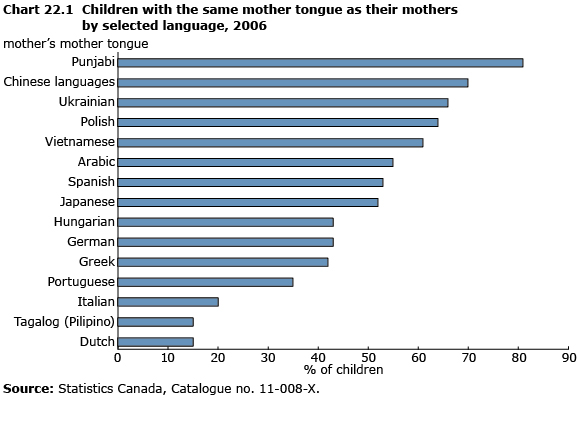Languages
Archived Content
Information identified as archived is provided for reference, research or recordkeeping purposes. It is not subject to the Government of Canada Web Standards and has not been altered or updated since it was archived. Please "contact us" to request a format other than those available.
Related information
Immigrant languages are transmitted from generation to generation primarily within the family, especially by mothers. The regular arrivals of immigrants who speak the immigrant language also help to keep a language alive.
For all language groups, immigrant languages were passed on to 41% of Canadian-born children (under 18 years) at the time of the 1981 Census. By the 2006 Census, immigrant languages were passed on to 55% of children—an increase of 14 percentage points.
Mothers and language transmission
One reason that languages are maintained is that recent female immigrants, particularly from South America, Asia and the Arab world, tend to transmit their language of origin to their Canadian-born children.
Like European immigrants who arrived before them, more than 80% of recent immigrants share a mother tongue with their spouse. Couples who have the same mother tongue are more likely to pass it on to the next generation.
The intensity of immigrant-language transmission—the proportion of children whose mother tongue is the same as their mother's—increased in 14 of the 20 language groups from 1981 to 2006, whereas it decreased in 4 European languages (Portuguese, Italian, Greek and Czech). Tagalog and Armenian were transmitted as often in 2006 as in 1981.
For Dutch, Italian, Creole and Tagalog, transmission of the mother's mother tongue to children under 18 (either as a mother tongue or as a language spoken most often or regularly at home), was less than 20%.
The intensity of language transmission to children under 18 was very high for the Armenian, Punjabi, Chinese, Persian, Turkish, Bengali and Urdu groups—it exceeded 70%. For Portuguese, Greek, Creole and Hindi, the percentages who reported speaking the language were much higher than the percentages who reported it as a mother tongue or as a language spoken at home.
While some factors—international travel, globalization, new technologies and the impact of the Canadian Multiculturalism Act—have encouraged the retention of immigrant languages, other factors have tended to reduce transmission. For example, immigrant mothers with higher education levels and greater knowledge of Canada's official languages are less likely to pass on their mother tongues.
Over the years, the profile of immigrants has changed in favour of more educated immigrants. Most notably, in 1981, 7% of immigrant mothers had a university degree, compared with 28% in 2006. Since more-educated women are less likely to pass on their mother tongue, language transmission would have been even greater if the education profile of immigrant mothers had not improved.
Transfer of language declines over generations
Immigrant-language transmission has declined when comparing one generation to the next generations. In 1981, 41% of mothers passed on their language; the corresponding proportion for their daughters in 2006 (when they were mothers) was 23%, a drop of 18 percentage points from one generation to the next.
Most of this decrease is linked to marriage: Canadian-born daughters of immigrant mothers often marry men who speak either English or French as their mother tongue, rather than the immigrant language. When spouses have different mother tongues, there is less chance that immigrant languages will be transmitted to their children.
This trend decreased intergenerational transfer for nine language groups, including Italian, Greek and Chinese; the pattern was stable for the Punjabi group. The language transmission of second-generation women to their children was strongest among those whose mother tongue is Punjabi (53%), followed by Greek (41%) and Spanish (30%).
Knowledge of the mother tongue is significantly lower in third-generation immigrants. About 10% of the grandchildren of the 1981 first-generation immigrant mothers had the same mother tongue as their mother and grandmother. Transmission to the third generation was below 10% for the German, Portuguese, Polish and Hungarian language groups. However, 33% in the Punjabi group had their grandmother's mother tongue, while 26% in the Greek group did.
The incidence of couples having the same mother tongue was high among second-generation Canadian women with Punjabi (83%) or Greek (56%) as their mother tongue.
- Date modified:

